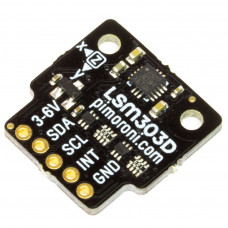Pimoroni LSM303D 6DoF Motion Sensor Breakout
This 6 Degrees of Freedom Motion Sensor Breakout can detect acceleration in three axes - X, Y, and Z - as well as three axes of magnetic heading. It's ideal for building into robots, rockets, and rovers, or anywhere else where you want to measure motion accurately. It's compatible with Raspberry Pi or Arduino.
The LSM303D 6DoF Breakout has an I2C interface and is 3.3V or 5V compatible. Like other Pimoroni breakouts, we've designed it so that you can solder a piece of right-angle header onto it and then pop it straight onto the bottom left 5 pins on your Raspberry Pi's GPIO header (pins 1, 3, 5, 6, 9).
It's also compatible with our fancy new Breakout Garden, where using breakouts is as easy just popping it into one of the six slots and starting to grow your project, create, and code.
Features
- LSM303D 6DoF Motion Sensor
- ±2/±4/±8/±12 gauss magnetic scale
- ±2/±4/±6/±8/±16 g linear acceleration
- 16 bit data output
- 3.3V or 5V compatible
- I2C interface, with address select via ADDR cuttable trace (0x1D or 0x1E)
- Reverse polarity protection
- Raspberry Pi-compatible pinout (pins 1, 3, 5, 7, 9)
- Compatible with Raspberry Pi 3B+, 3, 2, B+, A+, Zero, and Zero W
- Python library
- Datasheet
Kit includes
- LSM303D 6DoF Motion Sensor Breakout
- 1x5 male header
- 1x5 female right angle header
Software
We've put together a Python library that you can use to read data from your LSM303D 6DoF Breakout, and an easy one-line installer to install everything.
Software does not support Raspbian Wheezy.
Notes
- The trace between the solder pads (marked ADDR) can be cut (carefully with a craft knife) to change the I2C address from the default of 0x1D to 0x1E, meaning that you can use up to two sensors on the same Raspberry Pi or Arduino. If cut, the pads can be bridged again by soldering to reset the address to 0x1D.
Enter the code in the box below:








